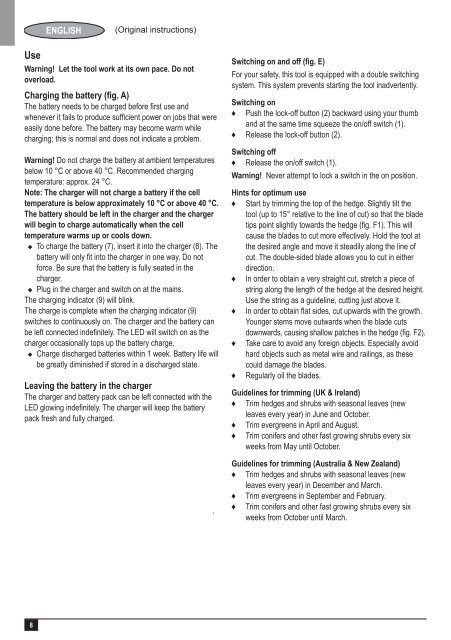BlackandDecker Tagliatrice Sen Cavo- Gtc1843l - Type H1 - H2 - Instruction Manual (Europeo)
BlackandDecker Tagliatrice Sen Cavo- Gtc1843l - Type H1 - H2 - Instruction Manual (Europeo)
BlackandDecker Tagliatrice Sen Cavo- Gtc1843l - Type H1 - H2 - Instruction Manual (Europeo)
Create successful ePaper yourself
Turn your PDF publications into a flip-book with our unique Google optimized e-Paper software.
ENGLISH<br />
(Original instructions)<br />
Use<br />
Warning! Let the tool work at its own pace. Do not<br />
overload.<br />
easily done before. The battery may become warm while<br />
charging; this is normal and does not indicate a problem.<br />
Warning! Do not charge the battery at ambient temperatures<br />
below 10 °C or above 40 °C. Recommended charging<br />
temperature: approx. 24 °C.<br />
Note: The charger will not charge a battery if the cell<br />
temperature is below approximately 10 °C or above 40 °C.<br />
The battery should be left in the charger and the charger<br />
will begin to charge automatically when the cell<br />
temperature warms up or cools down.<br />
To charge the battery (7), insert it into the charger (8). The<br />
force. Be sure that the battery is fully seated in the<br />
charger.<br />
Plug in the charger and switch on at the mains.<br />
The charging indicator (9) will blink.<br />
The charge is complete when the charging indicator (9)<br />
switches to continuously on. The charger and the battery can<br />
charger occasionally tops up the battery charge.<br />
Charge discharged batteries within 1 week. Battery life will<br />
be greatly diminished if stored in a discharged state.<br />
Leaving the battery in the charger<br />
The charger and battery pack can be left connected with the<br />
pack fresh and fully charged.<br />
For your safety, this tool is equipped with a double switching<br />
system. This system prevents starting the tool inadvertently.<br />
Switching on<br />
♦ Push the lock-off button (2) backward using your thumb<br />
and at the same time squeeze the on/off switch (1).<br />
♦ Release the lock-off button (2).<br />
Switching off<br />
♦ Release the on/off switch (1).<br />
Warning! Never attempt to lock a switch in the on position.<br />
Hints for optimum use<br />
♦ Start by trimming the top of the hedge. Slightly tilt the<br />
tool (up to 15° relative to the line of cut) so that the blade<br />
♦<br />
♦<br />
♦<br />
cause the blades to cut more effectively. Hold the tool at<br />
the desired angle and move it steadily along the line of<br />
cut. The double-sided blade allows you to cut in either<br />
direction.<br />
In order to obtain a very straight cut, stretch a piece of<br />
string along the length of the hedge at the desired height.<br />
Use the string as a guideline, cutting just above it.<br />
Younger stems move outwards when the blade cuts<br />
dow<br />
Take care to avoid any foreign objects. Especially avoid<br />
hard objects such as metal wire and railings, as these<br />
could damage the blades.<br />
Regularly oil the blades.<br />
Guidelines for trimming (UK & Ireland)<br />
♦ Trim hedges and shrubs with seasonal leaves (new<br />
leaves every year) in June and October.<br />
♦ Trim evergreens in April and August.<br />
♦ Trim conifers and other fast growing shrubs every six<br />
weeks from May until October.<br />
Guidelines for trimming (Australia & New Zealand)<br />
♦ Trim hedges and shrubs with seasonal leaves (new<br />
leaves every year) in December and March.<br />
♦ Trim evergreens in September and February.<br />
♦ Trim conifers and other fast growing shrubs every six<br />
weeks from October until March.<br />
8
















